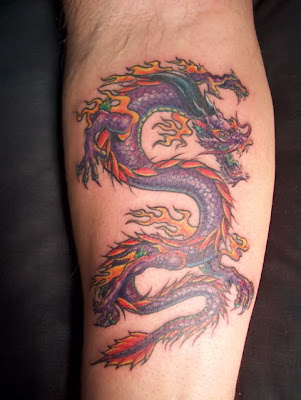Do you love the dragon tattoos? There are western and eastern dragon tattoos, no matter what they mean, but these kind of tattoos are really awesome! Men do love Dragon tattoos.

The dragon can be found in the mythology of hundreds of cultures and featured on ancient drawings and carvings from every corner of the globe. Because of the diversity of each culture's beliefs, there's lots of meanings behind this beautiful tattoo.
Depending on the cultural history of the dragon tattoo you are going to have inked on your body, you could be wearing a symbol of gentle wisdom and kindness or a fire-eating enemy ready to do battle. Legend has always depicted a hero slaying the dragon and saving the castle or the village from total destruction and winning the heart of a fair maiden.
 In Chinese cultures, the dragon symbolizes lightning, thunder and rain, which, in their ancient understanding, represented the uniting of the earth and water elements or fertility. Traditional Japanese tattooing is often about balance and the various characteristics of yin and yang. The dragon, in Japanese tattooing, is often portrayed with other symbols that represent both the balance and duality found in yin and yang.
In Chinese cultures, the dragon symbolizes lightning, thunder and rain, which, in their ancient understanding, represented the uniting of the earth and water elements or fertility. Traditional Japanese tattooing is often about balance and the various characteristics of yin and yang. The dragon, in Japanese tattooing, is often portrayed with other symbols that represent both the balance and duality found in yin and yang.
Another aspect of dragons, in the Far East, is their representation of either the four points of the compass or the nature symbols of water, earth, the underworld and the sky.
The Gnostics, who started a philosophical and religious movement in pre-Christian times, believed in the spiritual nature that lives in all of us and relied on their understanding and knowledge of God. Their belief about dragons revolved around the chaos of nature and the Spirit of God. Their fiery dragon could conquer all things.
Ancient Emperors and Celtic kings believed the dragon symbolized an existence that brought order and prosperity to their kingdoms. Very old documents and drawings about these powerful leaders often described them as heavenly dragons seated on a throne.
Dragons thought to be born of water can be credited with pleasant and benign activities, like bubbling springs and waterfalls, but they also drown people according to ancient understandings. Great horned dragons live underwater, beckoning people to their watery graves, if you read the beliefs and myths of Eastern Native Americans.
Water dragons possessing a glittering jewel flashing lightning bolts can be found in legends from Cambodia. Thunder and its power to bring rain was often believed to come from a pearl held in the dragon's mouth. The medieval paintings of St. George are full of dragons resembling sea serpents.
When reading these ancient beliefs and thinking, "How could people be so naïve?" keep in mind our current myths about dragons: the Loch Ness monster in Scotland and Ogopogo in Lake Okanagan, British Columbia.
We're not so far removed from believing in flying, fire-breathing dragons.
Depending on the cultural history of the dragon tattoo you are going to have inked on your body, you could be wearing a symbol of gentle wisdom and kindness or a fire-eating enemy ready to do battle. Legend has always depicted a hero slaying the dragon and saving the castle or the village from total destruction and winning the heart of a fair maiden.
 In Chinese cultures, the dragon symbolizes lightning, thunder and rain, which, in their ancient understanding, represented the uniting of the earth and water elements or fertility. Traditional Japanese tattooing is often about balance and the various characteristics of yin and yang. The dragon, in Japanese tattooing, is often portrayed with other symbols that represent both the balance and duality found in yin and yang.
In Chinese cultures, the dragon symbolizes lightning, thunder and rain, which, in their ancient understanding, represented the uniting of the earth and water elements or fertility. Traditional Japanese tattooing is often about balance and the various characteristics of yin and yang. The dragon, in Japanese tattooing, is often portrayed with other symbols that represent both the balance and duality found in yin and yang.Another aspect of dragons, in the Far East, is their representation of either the four points of the compass or the nature symbols of water, earth, the underworld and the sky.
The Gnostics, who started a philosophical and religious movement in pre-Christian times, believed in the spiritual nature that lives in all of us and relied on their understanding and knowledge of God. Their belief about dragons revolved around the chaos of nature and the Spirit of God. Their fiery dragon could conquer all things.
Ancient Emperors and Celtic kings believed the dragon symbolized an existence that brought order and prosperity to their kingdoms. Very old documents and drawings about these powerful leaders often described them as heavenly dragons seated on a throne.
Dragons thought to be born of water can be credited with pleasant and benign activities, like bubbling springs and waterfalls, but they also drown people according to ancient understandings. Great horned dragons live underwater, beckoning people to their watery graves, if you read the beliefs and myths of Eastern Native Americans.
Water dragons possessing a glittering jewel flashing lightning bolts can be found in legends from Cambodia. Thunder and its power to bring rain was often believed to come from a pearl held in the dragon's mouth. The medieval paintings of St. George are full of dragons resembling sea serpents.
When reading these ancient beliefs and thinking, "How could people be so naïve?" keep in mind our current myths about dragons: the Loch Ness monster in Scotland and Ogopogo in Lake Okanagan, British Columbia.
We're not so far removed from believing in flying, fire-breathing dragons.